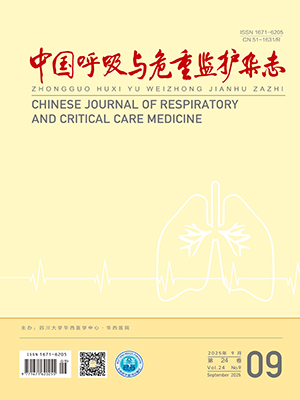| 1. |
Ritchie AI, Wedzicha JA. Definition, causes, pathogenesis, and consequences of chronic obstructive pulmonary disease exacerbations. Clin Chest Med, 2020, 41(3): 421-438.
|
| 2. |
Wang Z, Locantore N, Haldar K, et al. Inflammatory endotype-associated airway microbiome in chronic obstructive pulmonary disease clinical stability and exacerbations: a multicohort longitudinal analysis. Am J Respir Crit Care Med, 2021, 203(12): 1488-1502.
|
| 3. |
Torres-Sánchez I, Valenza MC, Cebriá I Iranzo MDÀ, et al. Effects of different physical therapy programs on perceived health status in acute exacerbation of chronic obstructive pulmonary disease patients: a randomized clinical trial. Disabil Rehabil, 2018, 40(17): 2025-2031.
|
| 4. |
MacLeod M, Papi A, Contoli M, et al. Chronic obstructive pulmonary disease exacerbation fundamentals: diagnosis, treatment, prevention and disease impact. Respirology, 2021, 26(6): 532-551.
|
| 5. |
曹校校, 傅安安, 陈荣, 等. 血清高敏C-反应蛋白、肿瘤坏死因子-α联合肺功能检测在诊断慢性阻塞性肺疾病中的应用价值分析. 中国卫生检验杂志, 2020, 30(3): 346-348,351.
|
| 6. |
Lin SH, He YP, Lian JJ, et al. Procalcitonin kinetics to guide sequential invasive-noninvasive mechanical ventilation weaning in patients with acute exacerbation of chronic obstructive pulmonary disease and respiratory failure: procalcitonin's adjunct role. Libyan J Med, 2021, 16(1): 1961382.
|
| 7. |
Ghobadi H, Hosseini N, Aslani MR. Correlations between serum decoy receptor 3 and airflow limitation and quality of life in male patients with stable stage and acute exacerbation of COPD. Lung, 2020, 198(3): 515-523.
|
| 8. |
Jin ZJ, Liu SQ, Zhan Q, et al. Decoy receptor 3 alleviates hepatic fibrosis through suppressing inflammation activated by NF-κB signaling pathway. Adv Clin Exp Med, 2018, 27(4): 441-447.
|
| 9. |
中华医学会呼吸病学分会慢性阻塞性肺疾病学组. 慢性阻塞性肺疾病诊治指南(2013年修订版). 中华结核和呼吸杂志, 2013, 36(4): 255-264.
|
| 10. |
中华医学会心血管病学分会心力衰竭学组, 中国医师协会心力衰竭专业委员会, 中华心血管病杂志编辑委员会. 中国心力衰竭诊断和治疗指南2018. 中华心血管病杂志, 2018, 46(10): 760-789.
|
| 11. |
Hattab Y, Alhassan S, Balaan M, et al. Chronic obstructive pulmonary disease. Crit Care Nurs Q, 2016, 39(2): 124-130.
|
| 12. |
Gilani MT, Razavi M, Azad AM. A comparison of Simplified Acute Physiology Score II, Acute Physiology and Chronic Health Evaluation II and Acute Physiology and Chronic Health Evaluation III scoring system in predicting mortality and length of stay at surgical intensive care unit. Niger Med J, 2014, 55(2): 144-147.
|
| 13. |
van Eeden SF, Hogg JC. Immune-modulation in chronic obstructive pulmonary disease: current concepts and future strategies. Respiration, 2020, 99(7): 550-565.
|
| 14. |
Singh D, Long G, Cançado JED, et al. Small airway disease in chronic obstructive pulmonary disease: insights and implications for the clinician. Curr Opin Pulm Med, 2020, 26(2): 162-168.
|
| 15. |
Tan DY, Walline JH, Ling BY, et al. High-flow nasal cannula oxygen therapy versus non-invasive ventilation for chronic obstructive pulmonary disease patients after extubation: a multicenter, randomized controlled trial. Crit Care, 2020, 24(1): 489.
|
| 16. |
Liu LL, Luan Y, Xiao L, et al. The predictive value of serum procalcitonin for non-invasive positive pressure ventilation in the patients with acute exacerbation of chronic obstructive pulmonary disease. Medicine (Baltimore), 2021, 100(16): e25547.
|
| 17. |
Bremmer DN, Moffa MA, Ma K, et al. Acute exacerbations of chronic obstructive pulmonary disease with a low procalcitonin concentration: impact of antibiotic therapy. Clin Infect Dis, 2019, 68(5): 725-730.
|
| 18. |
Ding GZ, Li WS. The expressions and significance of APN, D-D, IL-17 and hs-CRP in patients with acute exacerbation of chronic obstructive pulmonary disease. Eur Rev Med Pharmacol Sci, 2018, 22(19): 6463-6468.
|
| 19. |
程蕾, 刘杰峰, 庞剑, 等. 血清同型半胱氨酸、D-二聚体及前白蛋白与慢性阻塞性肺疾病急性加重合并呼吸衰竭相关性. 临床军医杂志, 2020, 48(12): 1479-1481.
|
| 20. |
Bou-Dargham MJ, Liu YH, Sang QA, et al. Subgrouping breast cancer patients based on immune evasion mechanisms unravels a high involvement of transforming growth factor-beta and decoy receptor 3. PLoS One, 2018, 13(12): 207799.
|
| 21. |
Fukuda K, Miura Y, Maeda T, et al. Expression profiling of genes in rheumatoid fibroblast-like synoviocytes regulated by tumor necrosis factor-like ligand 1A using cDNA microarray analysis. Biomed Rep, 2019, 1(1): 11-18.
|
| 22. |
刘敏, 王立芹, 杨茂勇, 等. 血清肿瘤坏死因子受体-6水平对AECOPD合并呼吸衰竭患者转归的影响. 中国医师杂志, 2019, 21(8): 1181-1184, 1189.
|
| 23. |
赵佳媛, 许婷婷, 吴笛, 等. DcR3 ALB水平与慢阻肺急性加重期合并呼衰患者转归关系. 河北医学, 2021, 27(9): 1436-1440.
|




